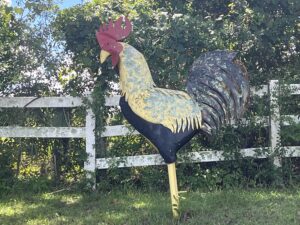
It was a giant rooster, no doubt about it, standing in all its glory on the grounds of Queen of Peace Catholic Church. Not something one typically comes upon every day. Yet there it was. about six feet in stature if I had to guess. I was so enthralled that I asked Dan to drive by it so I could snap a photo.
Where had it come from? How long had it been there? How on earth had I never noticed it before?
“Come to think of it, there are other roosters here too,” Dan said.
“Hmm… You’re right!” I said. “One that sits on a shelf to the right of the altar.”
“There’s at least one more, too,” he said, describing a black rooster in the courtyard.”
I was stumped. Roosters. Three of ’em. But why?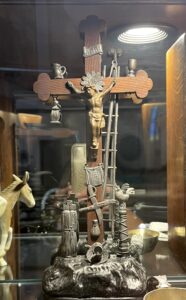
The obvious answer would be a reminder of Peter’s three-time denial of Jesus. As both Matthew and Luke tell us, upon hearing the cock crow, Peter wept bitterly. Perhaps the roosters are reminders of repentance.
But that seemed way too obvious. Surely there was more to it. Especially in light of the fact that some scholars believe the cock-crowing Jesus referred to wasn’t a rooster at all, but a trumpet that was blown to signify the changing of the Roman guard.
Not to mention that the Sanhedrin didn’t allow poultry in the city of Jerusalem. And sure, the roosters’ crows could’ve traveled, but let’s stay on track, shall we?
 Anyway, back to the roosters. Were there more of them, hidden throughout the grounds or slipped into the beautiful artwork and stained glass that adorn our church? Was this rooster hunt Fr. O’Doherty’s Catholic version of Where’s Waldo?
Anyway, back to the roosters. Were there more of them, hidden throughout the grounds or slipped into the beautiful artwork and stained glass that adorn our church? Was this rooster hunt Fr. O’Doherty’s Catholic version of Where’s Waldo?
I wondered.
Knowing an answer to my question wasn’t coming immediately roosters, I pulled out my best research tools and searched for further connections between roosters and Christendom. (OK, so I Googled it.)
Throughout the centuries, roosters have symbolized a number of things. The early morning crows represent the dawning of a new day—an awakening. It’s a symbol of change and hope and a reminder of Christ’s unending mercy.
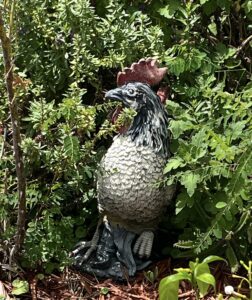
Pope Nicolas I ordered all Catholic churches to install a rooster weathervane on the steeple. Another pope, Gregory I, believed the rooster should be the official insignia for all of Christianity.
And while that was all well
and good, I wasn’t going to be satisfied until I discovered the rooster’s significance at my church.
So I met with the man himself, Fr. O’Doherty, and asked him to set the record straight. Was it a reminder of repentance that’s always available? A symbol of hope? Something more?
Turns out, none of my speculations had been accurate. Because it was not the affinity for said poultry that came first. It was the r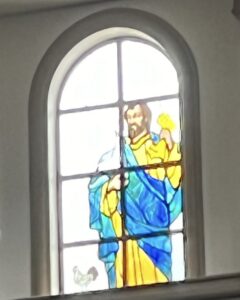 ooster itself—moreover it was the large rooster mentioned in the first paragraph. It’s actually about five feet tall and was a gift from a parishioner. And that one gift opened the proverbial chicken coop if you will, to a host of other cock-a-doodle-doos.
ooster itself—moreover it was the large rooster mentioned in the first paragraph. It’s actually about five feet tall and was a gift from a parishioner. And that one gift opened the proverbial chicken coop if you will, to a host of other cock-a-doodle-doos.
To date, I’ve uncovered several more roosters in and around Queen of Peace—most with Fr. O’Doherty’s help—bringing my total count to about eight or nine. He believes that’s about the extent of them.
At the end of the day, it’ll be up to the parishioners to interpret the roosters as they see fit. If nothing else, it leaves the door open for further speculation and stories—all of them true in their own way, of course. And as Father is fond of saying, “some of them actually happened.”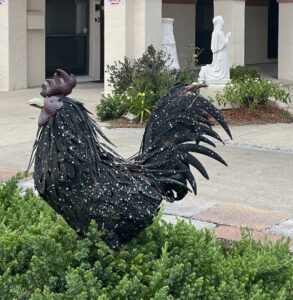
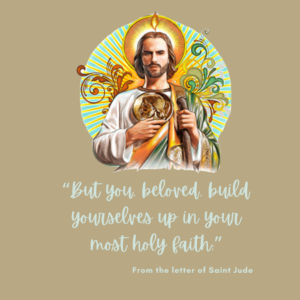 Have you ever wondered what the shortest books of the Bible are? That’s precisely where I found myself this morning as I flipped over to the Letter of Jude in honor of his feast day today. (Side note: he shares this day
Have you ever wondered what the shortest books of the Bible are? That’s precisely where I found myself this morning as I flipped over to the Letter of Jude in honor of his feast day today. (Side note: he shares this day





 Anyway, back to the roosters. Were there more of them, hidden throughout the grounds or slipped into the beautiful artwork and stained glass that adorn our church? Was this rooster hunt Fr. O’Doherty’s Catholic version of Where’s Waldo?
Anyway, back to the roosters. Were there more of them, hidden throughout the grounds or slipped into the beautiful artwork and stained glass that adorn our church? Was this rooster hunt Fr. O’Doherty’s Catholic version of Where’s Waldo?


